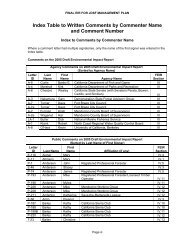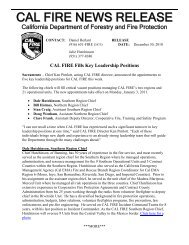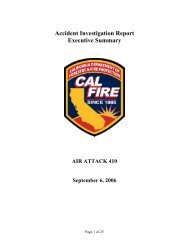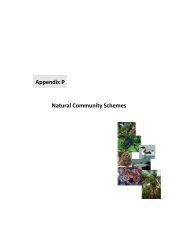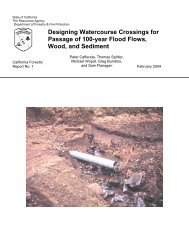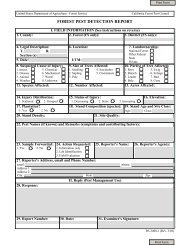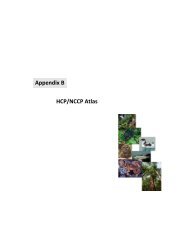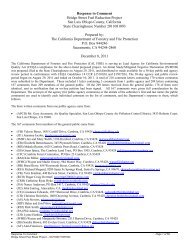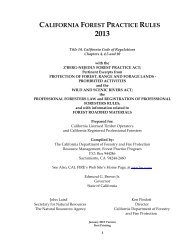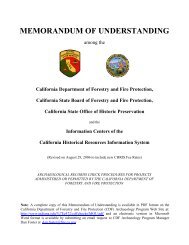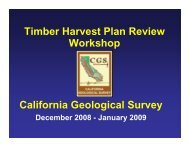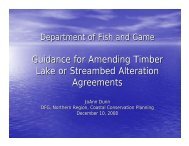Boggs Mountain Demonstration State Forest Draft ... - Cal Fire
Boggs Mountain Demonstration State Forest Draft ... - Cal Fire
Boggs Mountain Demonstration State Forest Draft ... - Cal Fire
Create successful ePaper yourself
Turn your PDF publications into a flip-book with our unique Google optimized e-Paper software.
<strong>Boggs</strong> <strong>Mountain</strong> <strong>Demonstration</strong> <strong>State</strong> <strong>Forest</strong> <strong>Draft</strong> Management Plan, June 2008<br />
Based on field work and forest inventory data, stands were assessed for meeting the Board of<br />
<strong>Forest</strong>ry late-successional forest definition. Due to the fact that the <strong>Forest</strong> was largely clearcut at<br />
the time of transfer to <strong>State</strong> ownership, most stands on the <strong>Forest</strong> are currently 50-60 years old,<br />
and no late-successional stands currently exist on BMDSF. Some of the functional characteristics<br />
of late-successional stands, such as large down logs, large decadent trees, and snags exist in<br />
scattered stands throughout the <strong>Forest</strong>. These attributes will be retained and recruited wherever<br />
feasible. Such stands provide a valuable starting point for the recruitment of additional adjacent<br />
acreage to late successional conditions through management.<br />
Structural characteristics such as snags, downed woody debris, decadent trees, and irregular tree<br />
characteristics (large branches, irregular form, hollows) will be retained to a density where they<br />
do not pose a safety hazard, fire hazard, impede the establishment and growth of new trees on<br />
the site, or provide a source of pest and disease to infect nearby healthy trees. Recruitment of<br />
large diameter snags will be accomplished by leaving, where feasible, dead trees, large trees that<br />
show signs of poor vigor, stress, or disease. No treatments are planned to actively create snags<br />
by girdling or topping live trees, unless prescribed on individual research installations. A key<br />
component of late-successional forest stands are the decadent components, snags, and large<br />
down logs. Snags from the dominant and predominant members of the stand are preferred to<br />
later become down logs.<br />
Silvicultural Methods<br />
Silvicultural methods will be used that promote growth and regeneration in order to develop and<br />
maintain an all-aged forest composed of a mosaic of age and size classes consistent with the<br />
desired future forest structure conditions. Specific research projects may occasionally utilize<br />
unconventional methods that do not follow the general direction for silvicultural methods<br />
described below.<br />
Uneven-aged management will be the dominant forest management method at BMDSF.<br />
Currently the ponderosa pine, Douglas-fir and mixed conifer stands are made up of groups and<br />
aggregates of even-aged size classes resulting from the 1949 and 1950 harvesting just prior to<br />
transfer of ownership to the <strong>State</strong>. Special and Alternative silvicultural prescriptions will be used<br />
to a lesser extent, as required to develop a fully regulated all aged forest. Even-aged methods will<br />
be used in a minority of cases, where warranted by fire prevention concerns, pest and disease or<br />
regeneration difficulties. Specific research projects may also use even-aged methods. In most<br />
cases, even-aged harvests will be a green tree retention method, i.e. a significant amount of<br />
mature trees from the previous stand will be left on site to provide structural and habitat diversity,<br />
and to enhance regeneration of new trees. Although timber harvesting will focus on the removal<br />
of conifers, some hardwoods may also be removed to maintain natural relative site occupancy of<br />
hardwood to conifer species for this area. The majority of the timber harvesting will be conducted<br />
under the following regeneration methods:<br />
Selection (unevenaged): Under the selection method, trees are harvested individually or in small<br />
groups sized from .25 acres to a maximum of 2.5 acres. Single tree selection will be the primary<br />
prescription for the Douglas-fir and mixed conifer stands. Group selection will be used within the<br />
pine stands to avoid species conversion and to maintain species diversity. Openings will be<br />
created to obtain more pine regeneration rather than the more shade tolerant Douglas-fir which is<br />
favored by single tree selection. For purposes of natural regeneration, group openings shall retain<br />
at least one seed tree per acre greater than 18 inches DBH, with full crown and superior<br />
phenotype. Artificial regeneration may be used to supplement natural regeneration.<br />
Transition (unevenaged): The transition method will be used to develop an unevenaged stand<br />
from a stand that currently has an unbalanced irregular or evenaged structure. The transition<br />
method involves the removal of trees individually or in small groups from irregular or evenaged<br />
stands to create a balanced stand structure and to obtain natural reproduction. This method will<br />
25



